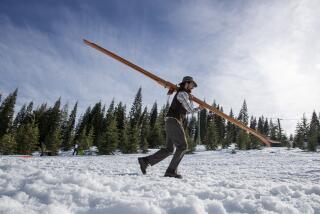Start Delayed Overnight by High Winds : It’s Up, Up and Away in Balloon Race
- Share via
PALM SPRINGS — Four colorful balloons rose into the desert sky at dawn Sunday in a belated start of the Gordon Bennett distance race in hopes that high-altitude wind currents will carry them into the Midwest.
About 3,000 people watched as the first helium balloon, the bright yellow Rosie O’Grady, floated up from Ruth Hardy Park at 6:45 a.m., about 10 hours after gusty winds forced officials to scrub Saturday night’s scheduled departure.
The other three balloons took off over the next hour. Competitors dumped sand ballast to reach the 12,000-foot level and catch easterly winds of 30 m.p.h. to 40 m.p.h.
The race is won by the balloon that travels the farthest, regardless of where it lands.
Regret Delay
Race officials said they regretted delaying the launch until morning because balloonists were forced to blow out precious helium expanding in the warmer daytime air. A nighttime launch preserves the cool, contracted gas.
“If we would have launched last night we would have gotten more distance,” said race director Tom Heinsheimer.
But he said the gusts of 25 m.p.h. Saturday night left him no choice but to decide at 9 p.m. on the postponement.
“We took a look at the situation and decided it wasn’t safe,” Heinsheimer said.
Despite the daytime launch, the winning balloon still could travel perhaps 1,000 miles, landing sometime Monday night as far away as Kansas or Nebraska, said meteorologist Carl Garczynski of the National Weather Service.
The record in the modern era of the race is 1,346 miles, set in 1981 by pilots Ben Abruzzo and Rocky Aoki.
Aggressive Strategy
On Sunday, three-time race winner Joe Kittenger, flying the Rosie O’Grady with co-pilot Sherry Reed, used the most aggressive launch strategy, dumping large amounts of sand ballast to quickly reach the altitude of the strong winds.
Jura, piloted by Karl Spenger of Switzerland with co-pilot Ronald Schuler, was next to take off, followed by Destiny carrying pilot Don Davis, an architect from Long Beach, and co-pilot Ron Martin.
The last balloon to take off was Benihana, piloted by Aoki, founder of the Benihana of Tokyo restaurant chain, with co-pilot George Hahn.
By Sunday evening, it was difficult to determine which balloon was leading the race. Just over six hours after lifting off, the Rosie O’Grady reported in over Kingman, Ariz., about 125 miles east of Palm Springs, headed northeast.
Jura was last heard from at dusk, northwest of Flagstaff, Ariz., which is about 300 miles from Palm Springs. She reported an altitude of 12,000 feet but gave no heading. Destiny had not been heard from since shortly after noon about a mile south of Parker, Ariz. Benihana was last reported 30 miles southwest of Parker and drifting northeast.
Parker and Kingman are both about 125 miles from Palm Springs, but Kingman is about 75 miles farther north. Race organizers rely on reports from balloon chase crews for updates on locations and communication can be difficult.
The race, named for New York Herald publisher Gordon Bennett, was inaugurated in 1906 when Bennett offered a prize to the balloonist who could float the greatest distance from a given point.
More to Read
Sign up for Essential California
The most important California stories and recommendations in your inbox every morning.
You may occasionally receive promotional content from the Los Angeles Times.









